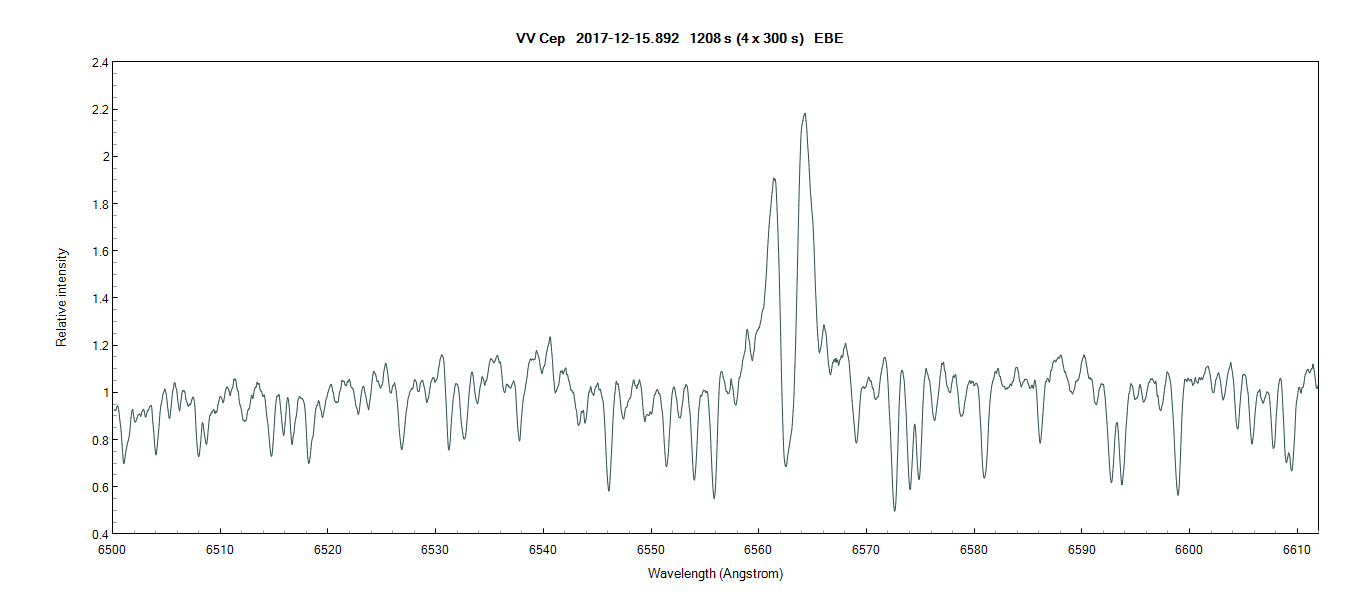VV Cep this night
-
Robin Leadbeater
- Posts: 1957
- Joined: Mon Sep 26, 2011 4:41 pm
- Contact:
Re: VV Cep this night
Here is a comparison of The Calspec and ELODIE 3.1 Vega spectra at the blue end and my instrument responses in this region for Vega (Calspec) and Altair (UVES)
Robin
Robin
- Attachments
-
- instresp_ 20170712_Altair_UVES_Vega_calspec.png (6.6 KiB) Viewed 12445 times
-
- flux_error_vega_elodie_v_calspec.png (11.88 KiB) Viewed 12445 times
LHIRES III #29 ATIK314 ALPY 600/200 ATIK428 Star Analyser 100/200 C11 EQ6
http://www.threehillsobservatory.co.uk
http://www.threehillsobservatory.co.uk
-
James Foster
- Posts: 456
- Joined: Sun Jan 24, 2016 7:14 am
Re: VV Cep this night
To: Robin
RE:......but when using Vega as a reference in this region for high resolution work, I use the Calspec spectrum. It is not ideal as it is lower resolution but filtering the measured spectrum to match produces an acceptable instrument response."
Thanks! I was uncomfortable using the ELODIE 3.1 as the spectra of Vega start so high (4100A is even worse). I'll reprocess my IR using Calspec in Isis database.
I'm also did a quick (5x300sec) exposure on VV Cep in Hb, So I should process this as well today.
James
RE:......but when using Vega as a reference in this region for high resolution work, I use the Calspec spectrum. It is not ideal as it is lower resolution but filtering the measured spectrum to match produces an acceptable instrument response."
Thanks! I was uncomfortable using the ELODIE 3.1 as the spectra of Vega start so high (4100A is even worse). I'll reprocess my IR using Calspec in Isis database.
I'm also did a quick (5x300sec) exposure on VV Cep in Hb, So I should process this as well today.
James
James Foster
eShel2-Zwo ASI2600MM Pro
Lhires III (2400/1800/600 ln/mm Grat) Spectroscope
LISA IR/Visual Spectroscope (IR Configured)
Alpy 200/600 with Guide/Calibration modules and Photometric slit
Star Analyzer 200
eShel2-Zwo ASI2600MM Pro
Lhires III (2400/1800/600 ln/mm Grat) Spectroscope
LISA IR/Visual Spectroscope (IR Configured)
Alpy 200/600 with Guide/Calibration modules and Photometric slit
Star Analyzer 200
-
James Foster
- Posts: 456
- Joined: Sun Jan 24, 2016 7:14 am
Re: VV Cep this night
Here is the comparison spectra btw the Calspec Vega with my Vega after a IR curve is applied:
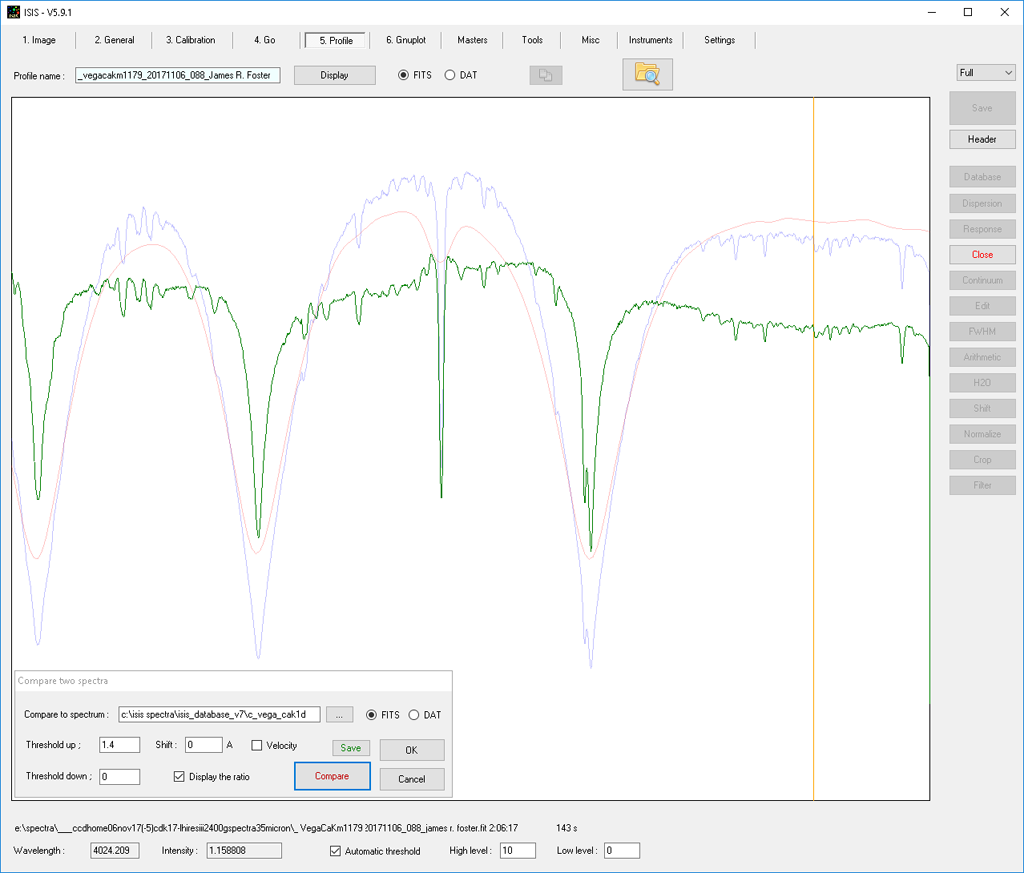
Here is my re-do of the VV cep spectrum in centered around the CaK line after applying the IR curve from the Vega IR above:
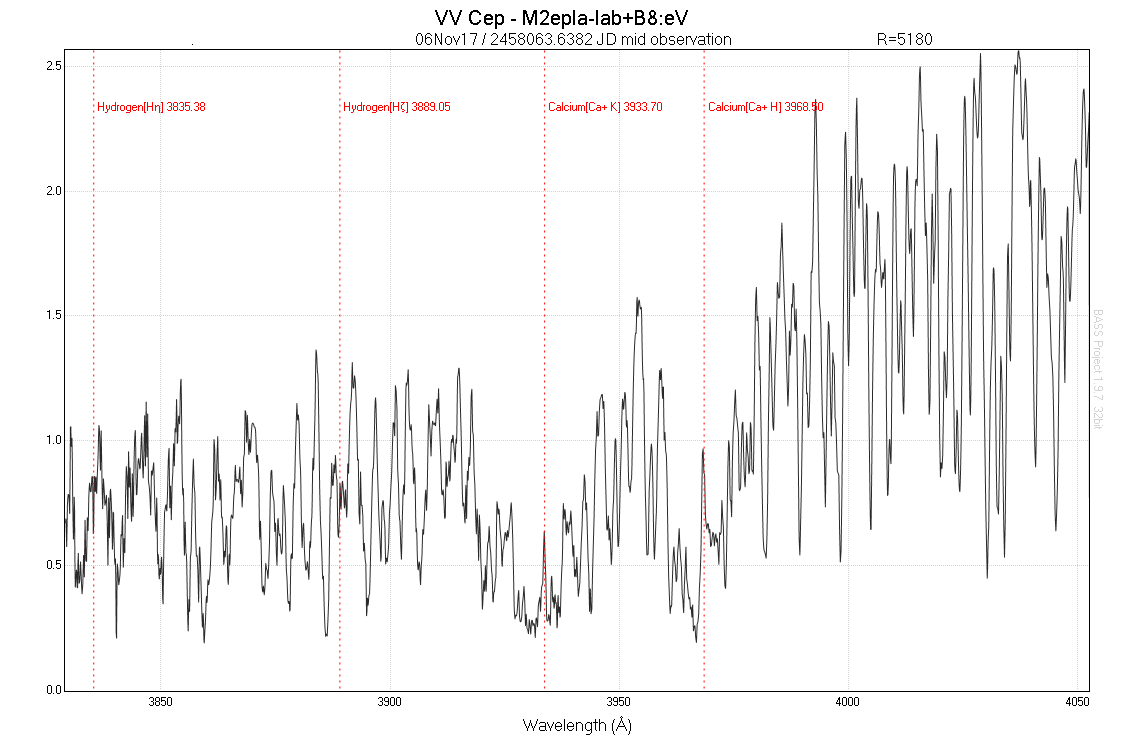
Here is a cropped version of the IS processed VV Cep spectrum from the display image command:

Will add the Hb spectrum tonight.........
James

Here is my re-do of the VV cep spectrum in centered around the CaK line after applying the IR curve from the Vega IR above:

Here is a cropped version of the IS processed VV Cep spectrum from the display image command:

Will add the Hb spectrum tonight.........
James
James Foster
eShel2-Zwo ASI2600MM Pro
Lhires III (2400/1800/600 ln/mm Grat) Spectroscope
LISA IR/Visual Spectroscope (IR Configured)
Alpy 200/600 with Guide/Calibration modules and Photometric slit
Star Analyzer 200
eShel2-Zwo ASI2600MM Pro
Lhires III (2400/1800/600 ln/mm Grat) Spectroscope
LISA IR/Visual Spectroscope (IR Configured)
Alpy 200/600 with Guide/Calibration modules and Photometric slit
Star Analyzer 200
-
Peter Somogyi
- Posts: 420
- Joined: Sun Jul 13, 2014 8:56 am
Re: VV Cep this night
James,
I'm looking forward to see your fits file showing up in the database!
It is important for me getting confirmation, as I can see this variation since the chromospheric eclipse (yet a question when the "total eclipse" is coming).
Once after subtracting Alp Ori (+ adding 0.5 constant) this is how my serie looks: So this 1:1 subtraction uncovering lots of unconfirmed variabilities above noise threshold, but even I'm unsure how valid are these!
Cheers,
Peter
I'm looking forward to see your fits file showing up in the database!
It is important for me getting confirmation, as I can see this variation since the chromospheric eclipse (yet a question when the "total eclipse" is coming).
Once after subtracting Alp Ori (+ adding 0.5 constant) this is how my serie looks: So this 1:1 subtraction uncovering lots of unconfirmed variabilities above noise threshold, but even I'm unsure how valid are these!
Cheers,
Peter
-
James Foster
- Posts: 456
- Joined: Sun Jan 24, 2016 7:14 am
Re: VV Cep this night
Here is my belated H-beta spectrum of VV Cep last night, 06Nov17, taken with the LhiresIII & 2400 l/mm grating using 35 micron slit with the CDK17 telescope from home:
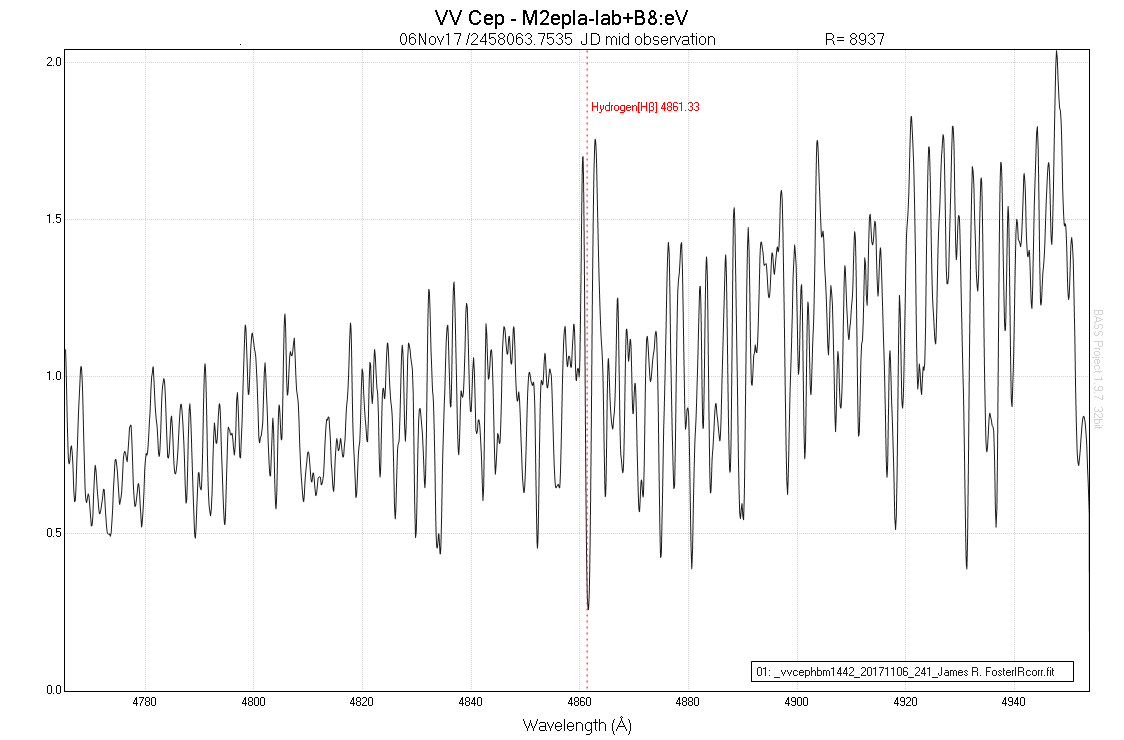
Conditions were not optimal, as clouds came and went out of the FOV. Hope to get "cleaner" data when skies clear-up.
James
P.S. Peter, let me know if you haven't receive these VV Cep Ha, Hb, & CaK data on email. Tc!

Conditions were not optimal, as clouds came and went out of the FOV. Hope to get "cleaner" data when skies clear-up.
James
P.S. Peter, let me know if you haven't receive these VV Cep Ha, Hb, & CaK data on email. Tc!
James Foster
eShel2-Zwo ASI2600MM Pro
Lhires III (2400/1800/600 ln/mm Grat) Spectroscope
LISA IR/Visual Spectroscope (IR Configured)
Alpy 200/600 with Guide/Calibration modules and Photometric slit
Star Analyzer 200
eShel2-Zwo ASI2600MM Pro
Lhires III (2400/1800/600 ln/mm Grat) Spectroscope
LISA IR/Visual Spectroscope (IR Configured)
Alpy 200/600 with Guide/Calibration modules and Photometric slit
Star Analyzer 200
-
Ernst Pollmann
- Posts: 461
- Joined: Mon Sep 26, 2011 7:16 pm
Re: VV Cep this night
James,
would you be so kindly to send me your Halpha spetrum from November 6th?!
Ernst
would you be so kindly to send me your Halpha spetrum from November 6th?!
Ernst
-
James Foster
- Posts: 456
- Joined: Sun Jan 24, 2016 7:14 am
Re: VV Cep this night
Here are my latest Ha and CaK spectra for VV Cep processed in Isis V5.91 taken with LhiresIII with 2400 l/mm grating & 35 micron slit with Planewave CDK17 reflecting telescope:
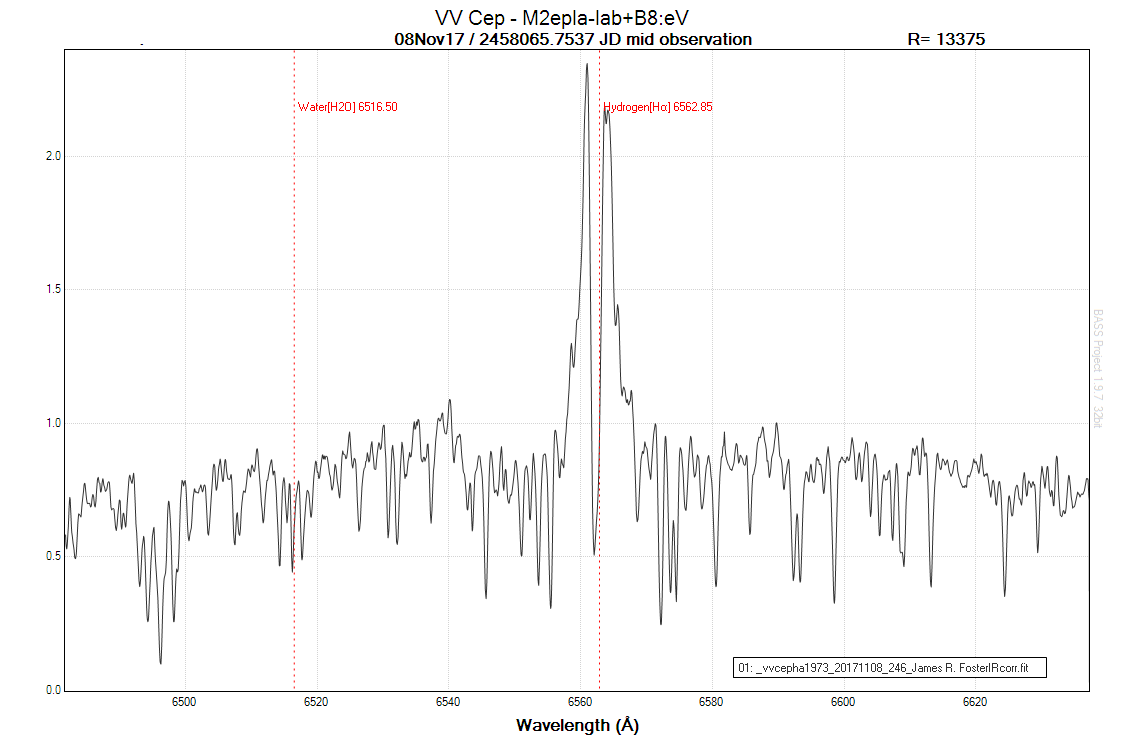
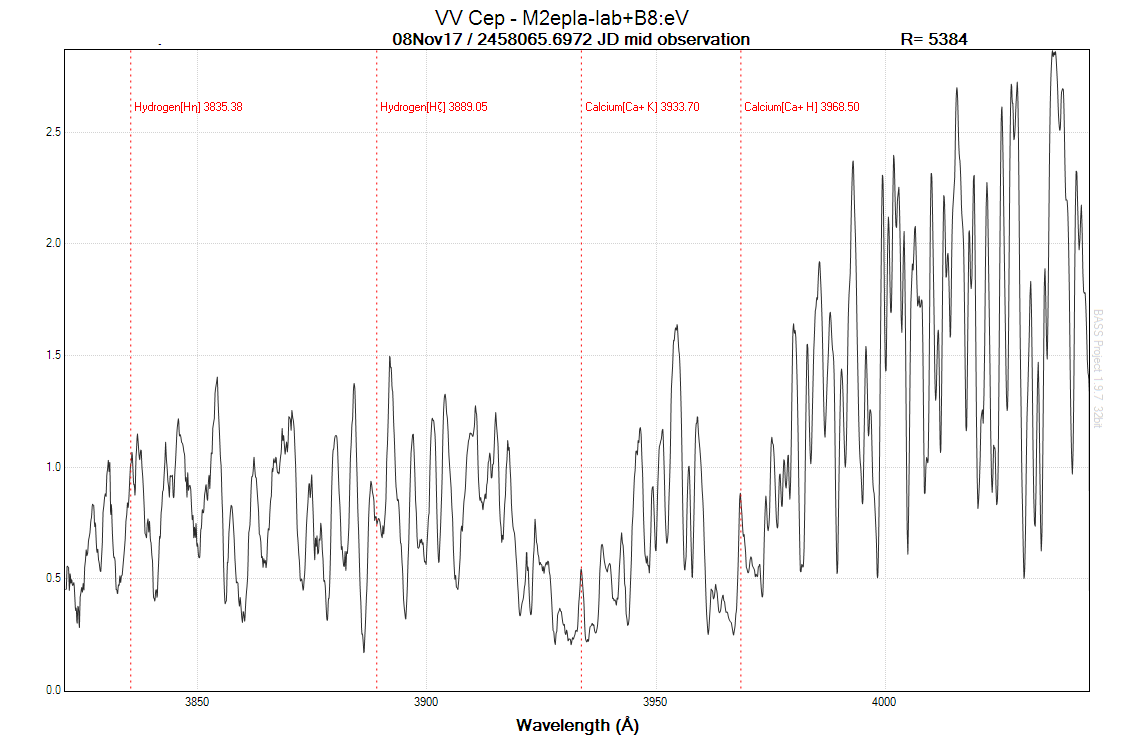
Atmospheric conditions were much better than 06Nov17 and I was able to expose 100 min (10X600 sec) in CaK and about 15 min (5x180 sec) in Ha before my house obscured
this high declination object. The 1st two CaK images were softly focused blueward of 390A, but this was corrected for the last 8 exposures. I used a fairly low Vega
(45 degs altitude) for the IR in CaK (CALSPEC) and gam PEG for IR in Ha.
James


Atmospheric conditions were much better than 06Nov17 and I was able to expose 100 min (10X600 sec) in CaK and about 15 min (5x180 sec) in Ha before my house obscured
this high declination object. The 1st two CaK images were softly focused blueward of 390A, but this was corrected for the last 8 exposures. I used a fairly low Vega
(45 degs altitude) for the IR in CaK (CALSPEC) and gam PEG for IR in Ha.
James
James Foster
eShel2-Zwo ASI2600MM Pro
Lhires III (2400/1800/600 ln/mm Grat) Spectroscope
LISA IR/Visual Spectroscope (IR Configured)
Alpy 200/600 with Guide/Calibration modules and Photometric slit
Star Analyzer 200
eShel2-Zwo ASI2600MM Pro
Lhires III (2400/1800/600 ln/mm Grat) Spectroscope
LISA IR/Visual Spectroscope (IR Configured)
Alpy 200/600 with Guide/Calibration modules and Photometric slit
Star Analyzer 200
-
Peter Somogyi
- Posts: 420
- Joined: Sun Jul 13, 2014 8:56 am
Re: VV Cep this night
James,
Your spectra in the CaII region seems to be compatible, after subtracting my Alp Ori from yours + adding 0.5 (PlotSpectra 1.5.1.0 doesn't support negative values): H8 has disappeared, so we have caught this important event together!
Congratulations !!!
Cheers,
Peter
Your spectra in the CaII region seems to be compatible, after subtracting my Alp Ori from yours + adding 0.5 (PlotSpectra 1.5.1.0 doesn't support negative values): H8 has disappeared, so we have caught this important event together!
Congratulations !!!
Cheers,
Peter
-
etienne bertrand
- Posts: 1041
- Joined: Mon Aug 31, 2015 11:26 am
Re: VV Cep this night
VV Cep of the night 02/12/2017
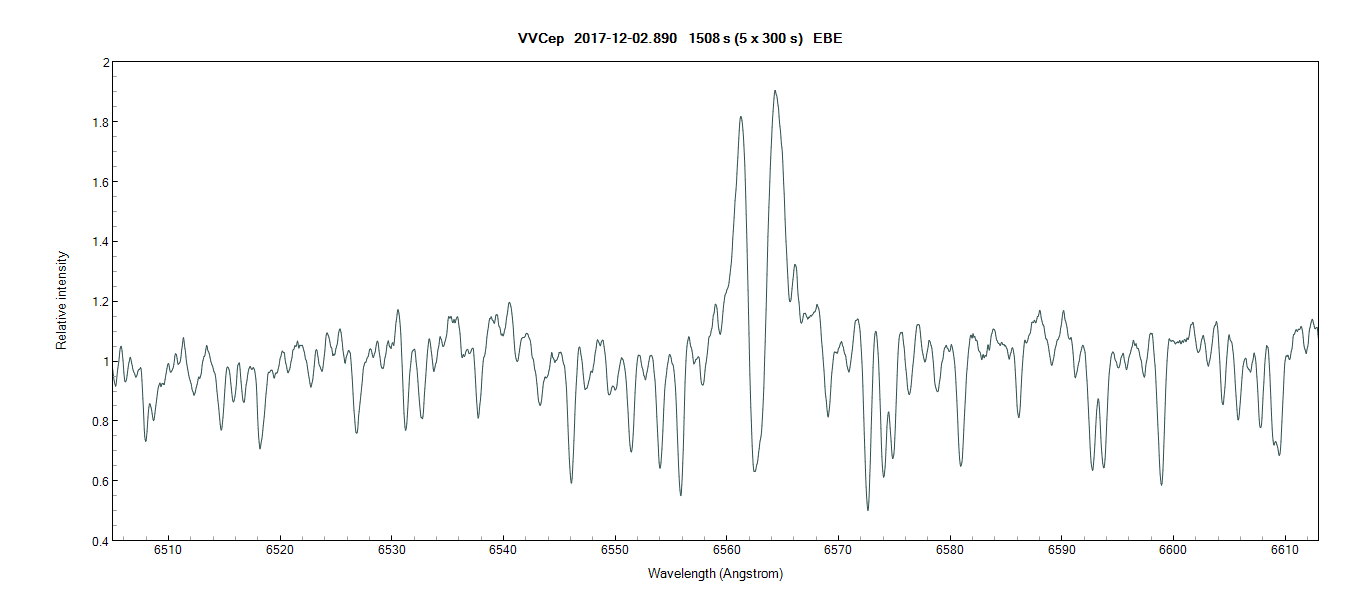
20/10/2017 - 02/12/2017
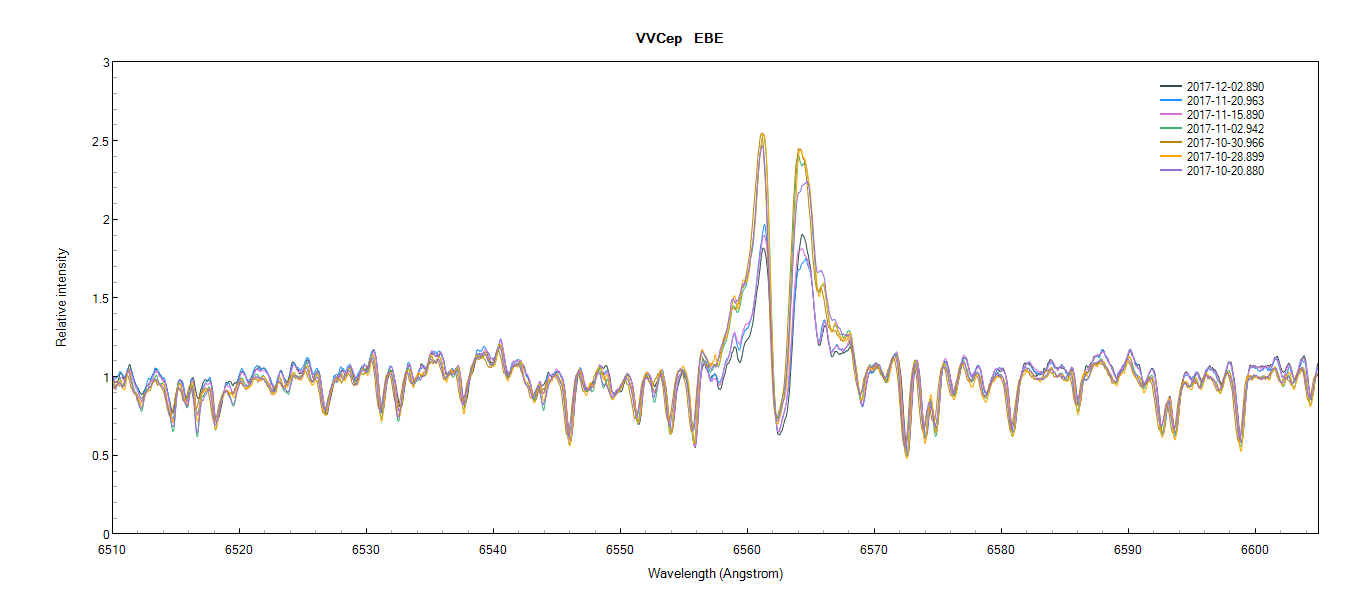

20/10/2017 - 02/12/2017

-
etienne bertrand
- Posts: 1041
- Joined: Mon Aug 31, 2015 11:26 am
Re: VV Cep this night
My last spectrum
